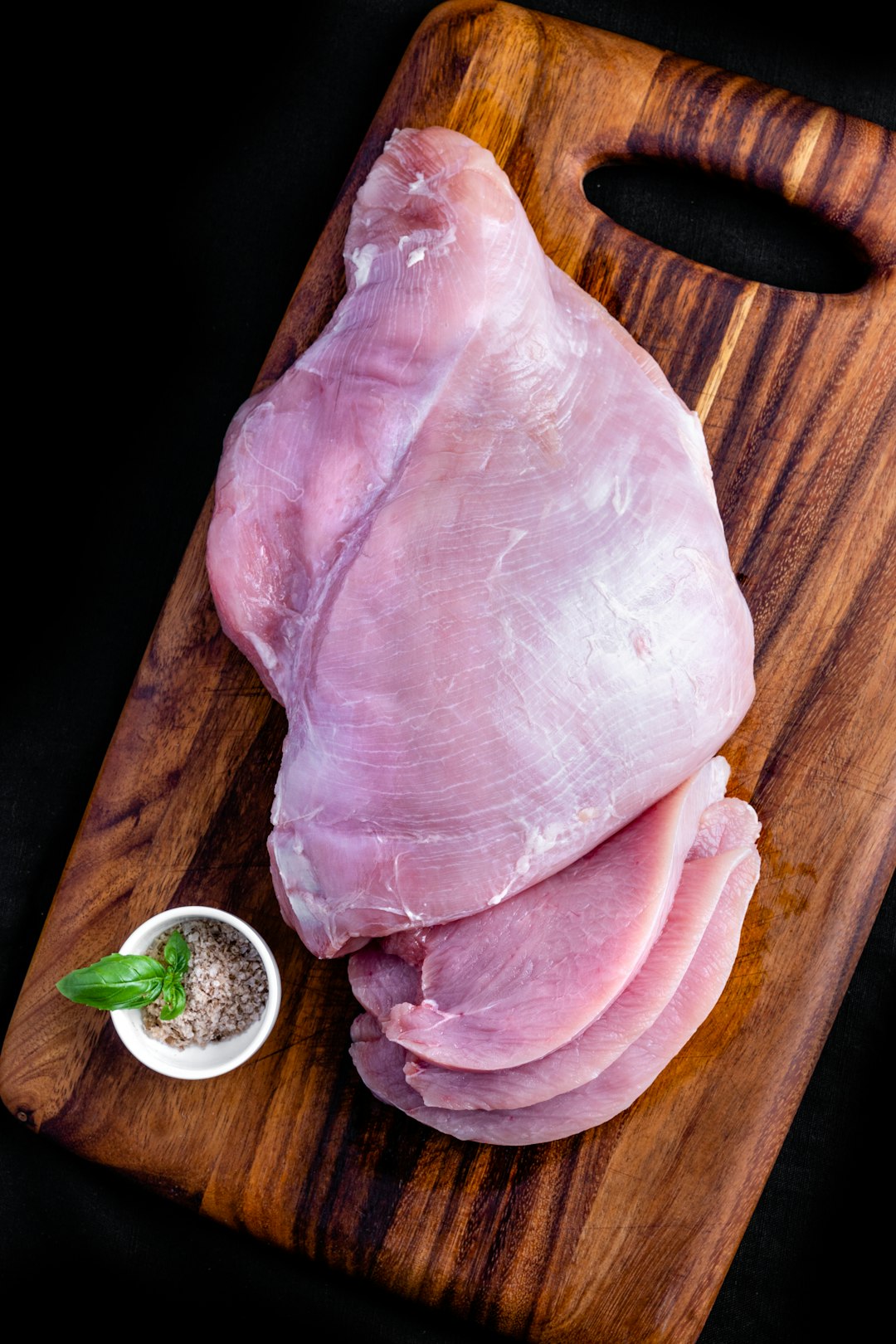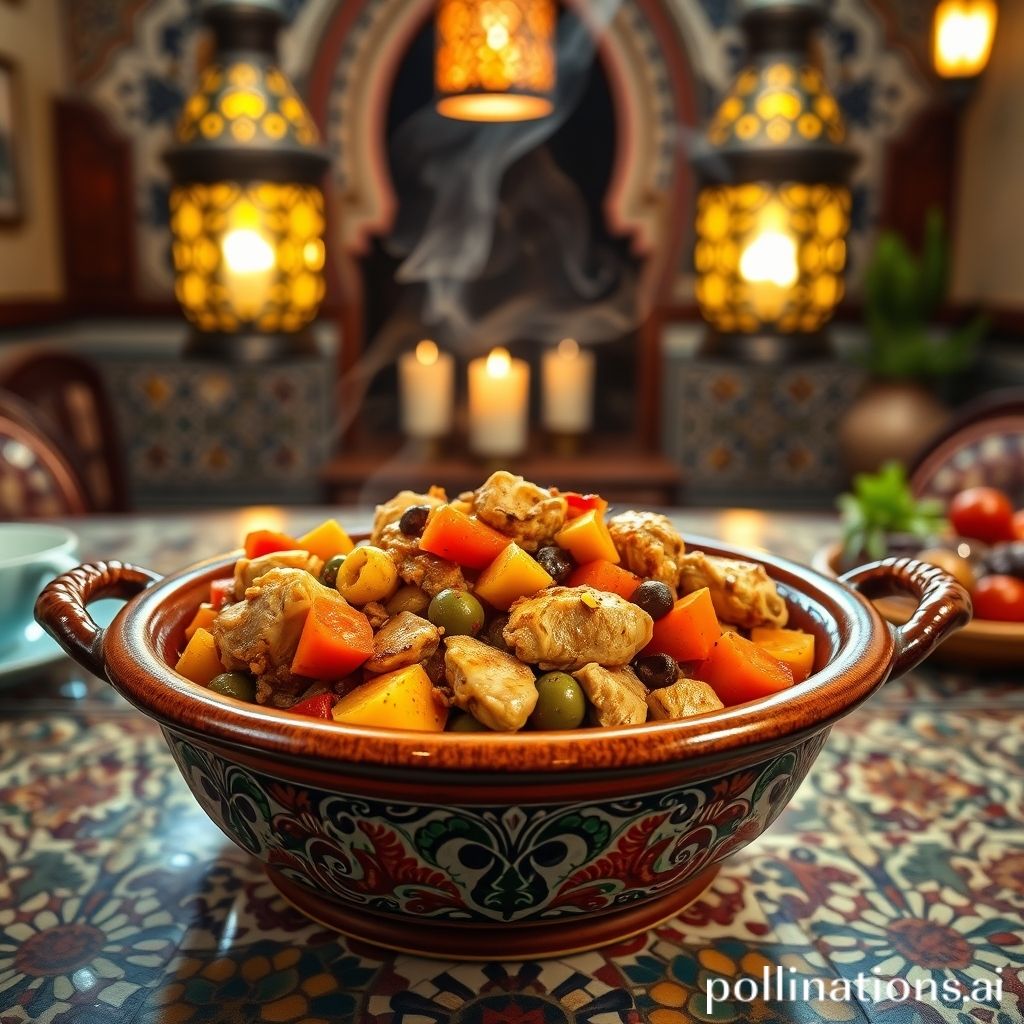Table of Contents
- Introduction
- Ingredients and Equipment Needed
- Preparation of Spices and Marinade
- Step-by-Step Cooking Instructions
- Traditional Accompaniments and Serving Suggestions
- Health Benefits and Nutritional Information
- Tips and Tricks for Perfecting the Tagine
- Regional Variations and Historical Context
- Common Mistakes to Avoid and Troubleshooting
- Conclusion
- Frequently Asked Questions
Introduction
Embark on a culinary adventure with Moroccan Spiced Chicken Tagine, a dish that harmoniously blends fragrant spices and tender chicken to create an unforgettable dining experience. As the centerpiece of Moroccan cuisine, this tagine encapsulates the essence of Morocco’s rich culinary heritage.
Imagine the warmth of cinnamon mingling with the zest of preserved lemons, the sweetness of dried apricots, and the earthiness of saffron, all simmering together to create a symphony of flavors that dance on your palate. With each bite, you’re transported to the bustling markets of Marrakech, where the air is thick with the intoxicating aromas of exotic spices.
But what makes this dish truly special is not just the ingredients, but the love and tradition infused into every step of its preparation. From the initial sautéing of aromatics to the slow, deliberate simmering that allows the flavors to meld, crafting a Moroccan Spiced Chicken Tagine is as much a journey of the heart as it is of the senses.
Prepare to dive deep into the recipe, uncover the secrets of its perfect balance of spices, and learn why this dish has been cherished for generations. Your journey into the world of Moroccan Spiced Chicken Tagine begins here.
Ingredients and Equipment Needed
To make a delicious Moroccan Spiced Chicken Tagine, you will need an array of ingredients and specific equipment. The key ingredients include chicken thighs or breasts, olive oil, onions, garlic, ginger, and a variety of spices such as cumin, coriander, turmeric, cinnamon, and paprika. Additionally, you will need preserved lemons, green olives, chicken broth or stock, fresh cilantro, and dried apricots or raisins for a touch of sweetness. Don’t forget salt and pepper to season accordingly.
For the equipment, a traditional tagine pot is ideal. This conical ceramic or clay pot is designed to lock in steam and moisture, ensuring the chicken remains tender and flavorful. If you don’t have a tagine pot, a Dutch oven or a deep, heavy-bottomed pan with a lid will also work. You will also need a cutting board, sharp knives, a wooden spoon for stirring, and measuring spoons to ensure precise amounts of spices. Optional but helpful tools include a citrus squeezer for the lemons and a spice grinder to freshly grind whole spices for maximum flavor.
Preparation of Spices and Marinade
The preparation of spices and marinade is crucial to achieving the authentic flavor of Moroccan Spiced Chicken Tagine. Begin by gathering a variety of spices such as cumin, coriander, paprika, cinnamon, turmeric, and ginger. These spices are the cornerstone of Moroccan cuisine, providing depth and warmth to the dish. Measure out one teaspoon of each spice and set them aside in a small bowl.
Next, prepare the marinade. In a large mixing bowl, combine the ground spices with minced garlic, grated fresh ginger, chopped cilantro, and freshly squeezed lemon juice. Add a few tablespoons of olive oil to help bind the ingredients together. Mix thoroughly to create a thick, aromatic paste.
Cut the chicken into pieces and place them in the bowl with the marinade. Ensure each piece is evenly coated with the spice mixture. For best results, cover the bowl with plastic wrap and let the chicken marinate in the refrigerator for at least two hours, or preferably overnight. This allows the flavors to penetrate deeply, making the chicken tender and flavorful when cooked in the tagine.
Step-by-Step Cooking Instructions
To make Moroccan Spiced Chicken Tagine, start by marinating the chicken. Combine garlic, ginger, cumin, coriander, paprika, turmeric, cinnamon, salt, and olive oil in a bowl. Add the chicken pieces and coat them thoroughly with the spice mixture. Let it marinate for at least an hour, preferably overnight.
Next, heat some olive oil in a tagine or a heavy-bottomed pot over medium heat. Add the chopped onions and sauté until they turn translucent. Stir in the marinated chicken, searing each piece until browned on all sides. Add in chopped tomatoes, preserved lemons, and olives. Pour in enough chicken broth to cover the ingredients partially. Bring the mixture to a simmer.
Cover the tagine and reduce the heat to low. Let it cook slowly for about 45 minutes to an hour, or until the chicken is tender and cooked through. Feel free to add more broth if needed. Garnish with chopped fresh cilantro before serving. This aromatic and flavorful dish pairs wonderfully with couscous or flatbread, making it a complete and satisfying meal.
Traditional Accompaniments and Serving Suggestions
Moroccan Spiced Chicken Tagine is a flavorful and aromatic dish that begs to be paired with traditional accompaniments. One of the most common sides is couscous, a light and fluffy semolina dish that soaks up the rich sauce perfectly. Often garnished with herbs like cilantro or parsley, and sometimes with toasted almonds or dried fruits, couscous complements the savory notes of the tagine.
Another popular side is Moroccan bread, known as khobz. This round, crusty bread is ideal for scooping up the delicious stew. Fresh salads, such as a simple tomato and cucumber salad with a light vinaigrette, add a refreshing contrast to the robust flavors of the tagine.
For an added touch of sweetness, you can serve the tagine with a side of steamed apricots or prunes, which not only enhance the depth of flavor but also bring a delightful texture to the meal. Harissa, a spicy North African chili paste, can be served on the side for those who crave an extra kick. To complete the experience, a pot of Moroccan mint tea is the perfect beverage to serve, offering a sweet yet refreshing finish to this exquisite dish.
Health Benefits and Nutritional Information
Moroccan Spiced Chicken Tagine is not only a delightful culinary experience but also offers numerous health benefits. This dish is rich in protein, thanks to the chicken, which is essential for muscle repair and growth. It also contains a variety of vegetables such as carrots, bell peppers, and tomatoes, contributing vitamins and minerals like Vitamin A, Vitamin C, and potassium. These nutrients support immune function, skin health, and heart health.
The spices used in Moroccan Spiced Chicken Tagine, such as turmeric, cumin, and ginger, are known for their anti-inflammatory properties. Turmeric contains curcumin, which has been shown to reduce inflammation and improve brain function. Cumin is a good source of iron, enhancing energy levels and boosting metabolism. Ginger aids in digestion and can help reduce nausea.
Furthermore, the use of olive oil in this dish provides healthy monounsaturated fats, which are beneficial for heart health. This dish is typically cooked slowly, ensuring that nutrients are retained and flavors are well-developed. Overall, Moroccan Spiced Chicken Tagine is a well-rounded meal that combines taste with nutrition, making it a great choice for those looking to enjoy a healthy and flavorful diet.
Tips and Tricks for Perfecting the Tagine
Creating the perfect Moroccan Spiced Chicken Tagine involves a blend of technique, ingredients, and a bit of patience.
First, invest in a quality tagine pot. Traditional clay tagines provide a unique cooking environment that enhances the flavors. If unavailable, a heavy-bottomed Dutch oven works as an alternative.
Next, focus on the spice mix. A blend of cumin, coriander, paprika, turmeric, cinnamon, and ginger is key to achieving that authentic Moroccan taste. Toast the spices lightly before adding them to release their full aroma and flavor.
Marinate the chicken in the spice mix and some olive oil for at least a few hours, or preferably overnight. This allows the flavors to penetrate deeply into the meat.
When cooking, start with a low heat. Slow-cooking is essential to break down the chicken until it is tender and to meld the spices together. Add finely chopped preserved lemons and green olives towards the end of the cooking time for an extra burst of flavor.
Lastly, be sure to serve your tagine with couscous or flatbread to soak up the rich sauce. Garnish with fresh herbs like cilantro or parsley for a refreshing contrast.
Regional Variations and Historical Context
The Moroccan Spiced Chicken Tagine is a dish that varies significantly across different regions of Morocco, reflecting the rich cultural diversity of the country. In coastal areas, such as Essaouira, you may find tagines that incorporate seafood along with traditional spices, while in the Atlas Mountains, the dish is more likely to include ingredients like prunes and almonds, giving it a unique sweetness. Central regions, such as Marrakech, are renowned for their complex spice blends, including ingredients such as saffron and preserved lemons.
The historical roots of the Moroccan Spiced Chicken Tagine can be traced back to the Berbers, who have been preparing tagines for centuries using earthenware pots that offer an efficient way to slow-cook food. Over time, as trade routes expanded through Morocco, the dish began to incorporate a variety of spices and ingredients introduced by Arab, Persian, and Mediterranean traders. This amalgamation of influences has contributed to the rich, layered flavors that define the dish today. The tagine not only exemplifies Moroccan culinary ingenuity but also serves as a delicious reminder of the country’s historical role as a crossroads of cultures and cuisines.
Common Mistakes to Avoid and Troubleshooting
When preparing Moroccan Spiced Chicken Tagine, it’s important to be aware of common mistakes and how to troubleshoot them. One common error is not allowing enough time for the chicken to marinate. Marination is crucial for the chicken to absorb the rich, aromatic spices. Ideally, marinate the chicken for at least a few hours, if not overnight.
Another mistake is using too much liquid. Tagines are traditionally slow-cooked dishes that should have a thick, concentrated sauce. Adding too much broth or water can dilute the flavors. Start with a small amount of liquid; you can always add more if needed.
Overcooking the chicken is also a frequent issue. Cooking a tagine low and slow is the key, but be careful not to let it cook for too long. This can result in dry, tough chicken. Cooking times can vary, so check the chicken periodically for tenderness.
If your final dish tastes bland, you may not have used fresh spices. Spices lose their potency over time, so make sure to use the freshest spices you can find. Lastly, remember to taste and adjust seasoning before serving. A final sprinkle of fresh herbs or a squeeze of lemon can enhance the flavors and bring your dish to life.
Conclusion
Embarking on the journey of preparing Moroccan Spiced Chicken Tagine opens your kitchen to an explosion of exotic flavors, rich cultural history, and a myriad of health benefits. This dish’s unique blend of spices, combined with the traditional slow-cooking method, creates an unparalleled dining experience that delights the senses and nourishes the body.
For those who have been inspired by this culinary adventure and wish to explore even more chicken recipes, we highly recommend The Chicken Bible: Say Goodbye to Boring Chicken with 500 Recipes for Easy Dinners, Braises, Wings, Stir-Fries, and So Much More. This comprehensive guide provides a treasure trove of ideas and techniques to elevate your chicken dishes, making every meal an exciting and delicious occasion. Don’t miss out on the opportunity to transform your cooking repertoire; click the link and get your copy today!

